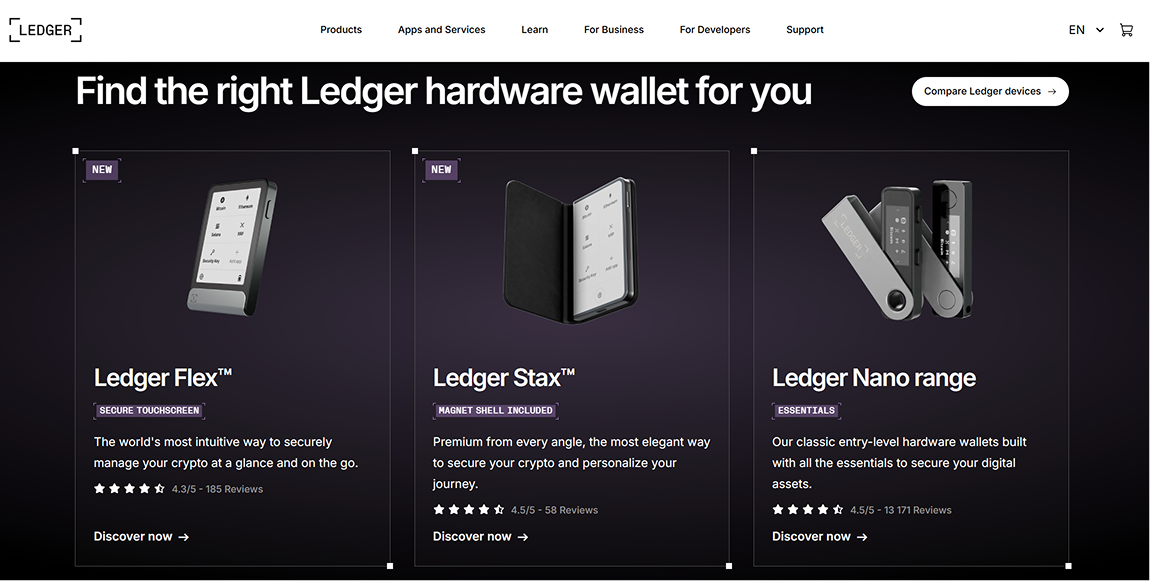

Deciding which one to purchase: Trezor or Ledger?
If you’re seriously planning on holding crypto long-term, a hardware wallet isn’t optional — it’s a must-have. And when it comes to hardware wallets, two names dominate the space today: Trezor and Ledger. Both promise to keep your coins safely locked, but they go about it in slightly different ways.
In this post, I’ll cover features that each brand offers, where they shine, and where they don’t shine as brightly. Hopefully, by the end, you’ll have a clear picture of which wallet makes more sense for your budget, habits, and level of crypto obsession.
General overview
Trezor was the pioneer in its niche — the first hardware wallet to hit the market back in 2014, created by SatoshiLabs. It set the standard for cold storage and still leans heavily on its open-source philosophy.

Today, Trezor offers two main models: the entry-level Trezor One and the more advanced Trezor Model T. Both are focused on transparency, security, and ease of use.
Ledger, launched in 2014 as well, took a slightly different route. Instead of going fully open-source, it focuses on its secure element chip — a bank-grade security feature designed to lock down your private keys.

Ledger’s product lineup includes the Nano S Plus and the Nano X. Nano X has Bluetooth support for mobile convenience. The company also runs Ledger Live, a polished companion app that doubles as a management hub for assets, staking, and even some DeFi tools.
Key features
When you’re choosing between Trezor and Ledger, the real question is what matters most: transparency, convenience, or sheer coin coverage. Here’s how the two stack up on the essentials:
Trezor
- Open-source firmware – transparent and auditable.
- Interface – managed through Trezor Suite (desktop) and Trezor Bridge for Chromebook/browser users.
- Supported assets – wide coverage, but not as extensive as Ledger.
- Security tools – passphrase protection and recovery seed backup.
- Integrations – works with third-party wallets like Electrum and Exodus.
Ledger
- Secure element chip – bank-grade hardware for private key protection.
- Ledger Live app – polished, beginner-friendly, and available on desktop and mobile.
- Supported assets – thousands of coins and tokens, making it one of the most versatile options.
- Integrations – broader support for mobile and browser-based wallets.
- Extra features – staking, DeFi access, and NFT management through Ledger Live.
Pros & cons
| Platform | Pros | Cons |
| Trezor |
|
|
| Ledger |
|
|
In short
- Trezor: Transparent, open-source, easy to use, and integrates with popular third-party wallets. But it supports fewer assets, lacks extras like staking, and only newer models include a secure element.
- Ledger: Supports thousands of coins, has a sleek app (Ledger Live), strong hardware security (secure element), and mobile integration. Downsides include closed-source firmware, past trust controversies, and a more locked-in ecosystem.
Pricing
| Brand & model | Price (USD) | Main features | Best for |
| Trezor Safe 5 | $169 |
|
Users who want premium usability with modern security and frequent, comfortable use. |
| Trezor Safe 3 | $79 |
|
Budget-minded buyers who want a modern Trezor with a Secure Element and don’t need a touchscreen. |
| Trezor Model One | $49 |
|
Lowest-cost cold-storage option for basics; good starter wallet if you don’t need every asset or feature. |
| Trezor Model T | $129 |
|
Power users who want a touchscreen Trezor with robust integrations at a mid-tier price (when discounted). |
| Ledger Nano S Plus | $79 |
|
Solid, entry-level choice if you don’t need Bluetooth or mobile iOS; great all-around value. |
| Ledger Nano X | $149 |
|
People who manage assets on the go and want seamless mobile + desktop with strong coin coverage. |
What the price differences really tell you
- Value vs premium: Model One and Nano S Plus can provide strong security without non-essential fluff. If your goal is just storing coins, these are often “good enough.” But pay a little more and you get features that make daily usage smoother: better displays, secure elements, more coin support.
- Secure element: Some Trezor models (Safe 3, Safe 5) now include a secure element chip, which helps close that very gap that Ledger has historically claimed as an advantage. If you care a lot about chip-level protection, these newer Trezors bring you closer.
- Mobile vs desktop & bluetooth: If you want to use your hardware wallet with your phone (especially iOS), or want wireless/Bluetooth functionality, then Nano X leans in your direction. Without that need, the cheaper USB-only ones will serve well.
- Display & ease of input: Touchscreens (Model T, Safe 5) vs buttons (Model One, Safe 3) matter. If you dislike dealing with teeny-tiny buttons for PIN or passphrases, paying more for a touchscreen might be worth it.
Ease of use & mobile compatibility
Both wallets are designed to keep your crypto safe, but when it comes to day-to-day interaction, that’s where they start to diverge.
Trezor keeps things simple. Its setup process is straightforward, and the Trezor Suite desktop app gives you a clean, no-nonsense interface for managing assets. If you’re a proud Chromebook owner or prefer browser access, Trezor Bridge lets you connect and manage your wallet without fuss. The trade-off? Mobile support is pretty limited — there’s no dedicated Trezor app, so you’ll mostly be tethered to a desktop or laptop.
Ledger feels more polished out of the box. The Ledger Live app is available on desktop and mobile (iOS and Android), which means you can check balances, send coins, or even stake directly from your phone.
The Nano X model goes a step further with Bluetooth, so you don’t even need a cable to connect. This makes Ledger especially convenient if you want to manage assets while on the road or if your phone is your primary device.
Bottom line: Trezor keeps it simple and desktop-focused, while Ledger leans into mobile convenience and a smoother all-in-one experience. Which is better depends on how and where you plan to manage your crypto.
Trezor vs Ledger: Security
Despite sharing the same goal, Trezor and Ledger use very different approaches towards security.
Trezor is all about transparency. Its software is open-source, so anyone can review the code. The older Model One and Model T rely on software protections, while the newer Safe 3 and Safe 5 add a Secure Element chip (the same type of tech found in passports) to block brute-force or physical attacks.
For backups, Trezor lets you use a standard recovery phrase or a stronger option called Shamir Backup (also known as SLIP39), which splits your recovery into multiple parts.
Ledger goes heavy on hardware. Every device comes with a Secure Element chip where your keys are generated and stored. The device screen is tied to that chip, which means what you see on the wallet is what you actually sign — safe even if your computer is infected.
Firmware is closed-source, but Ledger runs regular “genuine checks” to prove your device hasn’t been tampered with. Backups are the usual 24-word phrase, and you can also opt into Ledger Recover, a paid service that helps restore your wallet if you lose the phrase (though not everyone loves the idea).
Wrapping up
At the end of the day, both Trezor and Ledger do what matters most: they keep your private keys… well, private. The differences come down to what you value more.
- Go with Trezor if you like open-source transparency, straightforward desktop use, and flexible backup options like Shamir.
- Choose Ledger if you want maximum coin support, mobile convenience, and hardware security built around a secure element chip.
There’s no “wrong” choice here — only the one that best fits your habits, budget, and comfort level. Whatever you pick, just keep in mind that you’re already ahead of most crypto holders just by using a hardware wallet.





